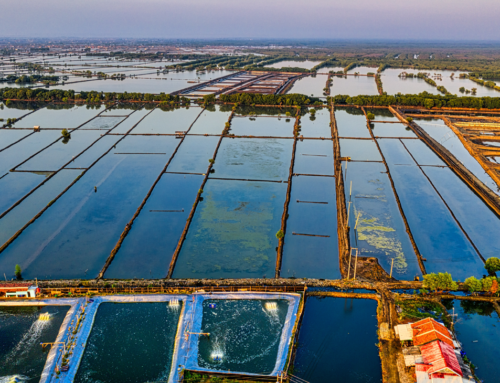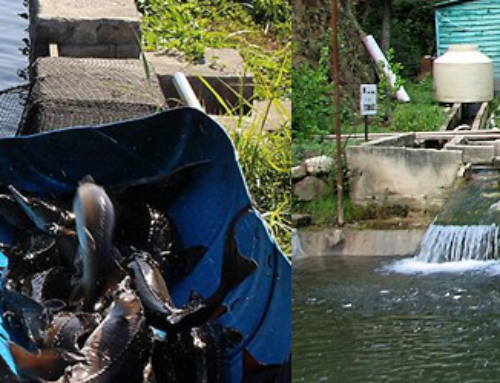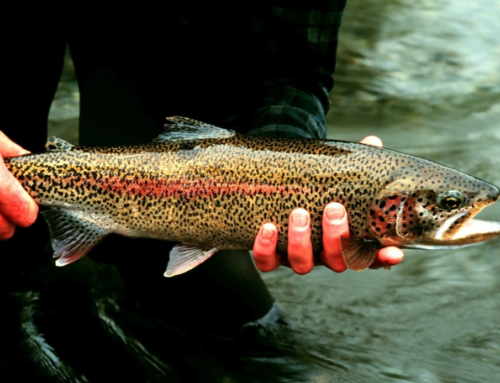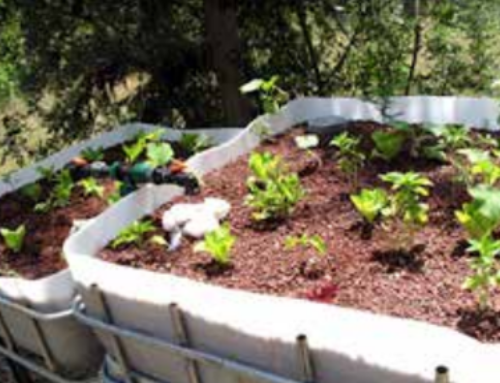FISH STOCKING DENSITY
To recover the high capital cost and operating expenses of aquaponic systems and earn a profit, both the fish-rearing and the hydroponic vegetable components must be operated continuously near maximum production capacity. The maximum biomass of fish a system can support without restricting fish growth is called the critical standing crop. Operating a system near its critical standing crop uses space efficiently, maximises production and reduces variation in the daily feed input to the system, an important factor in sizing the hydroponic component. There are three stocking methods that can maintain fish biomass near the critical standing crop: sequential rearing, stock splitting and multiple rearing units.
Pond Carriage Capacity
The maximum weight of fishes a pond/tank can contain successfully without crisis is referred to as the “carriage capacity” of pond/tank. The carriage capacity of a pond/tank is a factor of water management technique adopted in a fish farm. In other words, re-circulatory system of water management can accommodate higher number of fishes per square meter in pond or per cubic meter in tank. In any system, there are factors that affect the appropriate stocking density
A Simple Method to Calculate Fish Stocking Density for Pond
Although the research was done in the USA, we can still make use of the recommendations with little or no adjustment to suit our tropical environment and African catfish that we culture in our region. The calculation was done on static water pond with depth not specified. However, the volume of water must be known, and I do hope we can all calculate water volume in any form of container based on our knowledge of elementary mathematics. Good! Another important thing you must predetermine before calculation begins is target size at harvest as well as expected mortality rate — usually between 5-10 percent. Generally, according to the recommendation of the research, a static pond system has maximum stocking capacity of 1.8kg of fish per meter square. Arithmetically, the calculation is simple: 2000-meter square of static pond water can carry 3,600kg of catfish.
There is more to the above calculation because we still don’t know the number of fishes to stock. Assuming your static pond water volume is 2000-meter square and you intend to produce average size of 900 grams of catfish at end of culturing season with an average mortality rate of 5 percent, and then calculation can be done thus:
 2000-meter square of water volume multiplied by 1.8 divided by 900 gram plus 5 percent expected mortality rate i.e. (2000m2 x 1.8kg/900g) + 5% (2000m2 x 1.8kg/900g)
2000-meter square of water volume multiplied by 1.8 divided by 900 gram plus 5 percent expected mortality rate i.e. (2000m2 x 1.8kg/900g) + 5% (2000m2 x 1.8kg/900g)
(3600/0.9) + 5%
4000+ 5% of 4000
4000+ 200 = 4200 juvenile
Note: The above calculation is recommended for a mono-culture system of catfish farming and to maintain water quality, each fish should not be fed above 20 g.
Fish Stocking Density in Aquaponic Systems (critical standing crop)
Aquaponic Systems Carriage Capacity is dependent to its specifications. For example, for system with the following specifications:
- System Type: (DWC) Deep Water Culture
- Filtration: Biofilter and Clarifie
- Oxygen Level: High (>9ppm)
- Optimum Stock Density: 21-30 Kg/1000 Liter
- Number of Fish: 72 per 1000 Litre
With the hybrid filtration:
- System Type:(DWC) Deep Water Culture
- Filtration: Hybrid
- Oxygen Level:High (>9ppm)
- Optimum Stock Density:31-40 Kg/1000 Liter
- Number of Fish:100 per 1000 Litre
To calculate Carriage Capacity for your system specifics.
This is the recommended starting fish stock level for a DWC system with biofilter and clarifier filtration system. As the biofilters become more effective (usually over 6 months) the stock level can be increased.
- System Type: (DWC) Deep Water Culture
- Filtration: Clarifier (Biofilter take 3 to 6 months to become fully effective)
- Oxygen Level: Medium to High (>8-9 ppm)
- Optimum Stock Density: 11-20 Kg/1000 Liter
- Number of Fish: 43 per 1000 Litre
Maximum Carriage Capacity Indicators
Response to feed reduces drastically as soon as your pond reaches its carriage limit. This is due to the fact that water environment condition will no longer be conducive for healthy growth. At this point in time, fishes only feed to survive and not to grow. However, the best option is to sell off your grow-out fishes after you notice drop in their feeding habit in spite of your effort to improve their water environment.
Feed Conversion Ratio becomes lower due to overcrowding. It is a normal practice in fish farming to measure some sample fishes regularly to monitor the growth of the general stock through sampling. This will help farmer to monitor closely how well his stock convert feed to flesh. When the growth becomes less obvious it could be that your pond capacity can no longer support their healthy growth further.
Depletion in the Dissolved Water Oxygen is a sign of overcrowding especially in pond system. The dissolved oxygen in water is overused and fishes look for an alternative way of surviving through atmospheric oxygen. The alternative way of breathing will cost a level of energy lost which will slow down their growth. The users of pond system should note that depleted water oxygen is a sign that your pond has reached its elastic limit in terms of carriage capacity.
Water Temperature increases significantly as pond carriage capacity reach its elastic limit. The heat generated through activities of fishes becomes intense as density of your fishes increase due to growth. Your fish will not die due to an increase in water temperature, but they will only live to merely survive the harsh environment. Take a precise action when temperature becomes abnormal.
Constant Mortalities occur regularly when resources meant for survival of fishes in pond becomes depleted. The weak ones will feel the effect of this shortage most. Increase in ammonia gas in water could trigger some infection which will spread rapidly because of huge density of fishes in the pond. Most of the time, mortality re-occur after treatments and more fishes have to die to ensure balance and stability in the pond. Once your pond reaches its maximum carriage capacity, mortality becomes a common occurrence.
Watercolour changes from lemon green to grey or blackish at a given rate of water inflow. The environment will be too harsh for plants that give pigment to water in the pond to survive. Also, the rate of pollution increases as density of fishes grows leading to change in watercolour. As a matter of fact, watercolour is one of the ways you can use to assess the well-being of your stock. When watercolour changes constantly despite water in flow, it might be the result of increase in activities of your stocks.
Other indicators are internal attacks among fishes, restriction in movement of stock, too busy water surface, intensive competition for feed and regular restlessness.
Conclusion
The above calculation might not be 100 percent applicable to all fish species and farming system but can be used as basis upon which stocking density can be calculated with due consideration to other unique factors in our environment. It must also be noted that stocking capacity of pond/tank can increase significantly subject to source and quality of water. The increase in the level of dissolved oxygen in water can help increase the level of stocking density as waste is removed from pond/tank either through flow through system or re-circulatory system.
Best Time to Introduce Fish
The best time of year to introduce fish is from autumn to early spring. At this time of the year water temperatures and the oxygen demands of the fish are at their lowest and the oxygen capacity of the water at its highest. Moving fish during this period is often less stressful than during warmer temperatures and fish tend to recover more quickly from the upset of the stocking process. In addition, many naturally occurring parasites and pathogens will be at relatively low numbers, posing less of a threat to acclimatising fish.
Introduction Of Disease
One of the biggest risks of introducing new fish to a water is that the fish may bring parasitic diseases with them. To minimise the risk of introducing disease, ensure that a valid health check is carried out. Once a damaging parasite is introduced it is practically impossible to eradicate, and it will continue to damage the fish and the fishery. A health check performed by a private fish health consultant may initially appear expensive, but in the long term it will represent peace of mind and money well spent.
There are several ways of minimising the disease risks associated with stocking:
- Always stock fish from only one source water. This reduces the chances of introducing disease from an infected water.
- Make sure that the fish sample on which a health check carried out is representative of the species and size of fish to be introduced.
- Make sure that the health check is fully understood. It is likely that any parasites listed will be given their scientific (Latin) names. Make sure that the parasites are not potentially harmful and what impact they might have.
The golden rule of any stocking operation has to be “if in doubt, don’t stock”. If after considering all the points highlighted in this page, it is still not possible to assess the impact an introduction is likely to have on a fishery, then the best option is not to do it.





